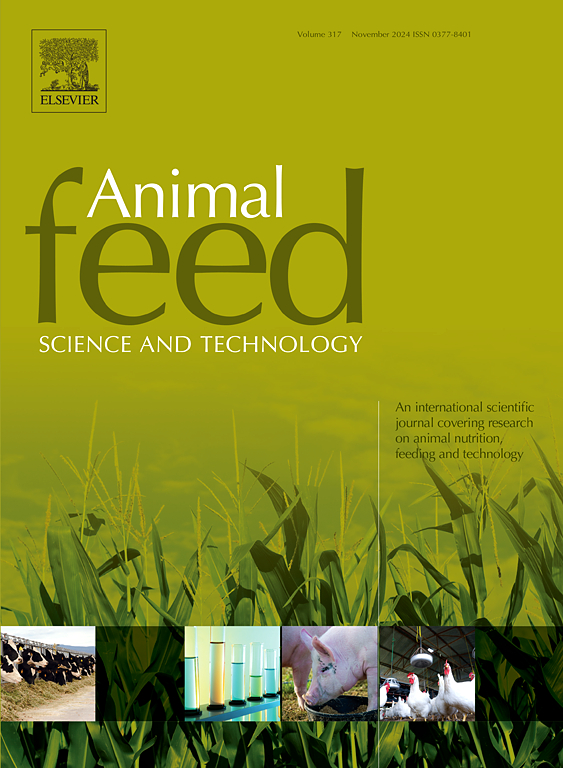饲粮中添加植酸酶和蛋白酶对低磷非洲鲶鱼(Clarias gariepinus)鱼种动物技术、抗氧化和免疫指标的协同效应
IF 2.5
2区 农林科学
Q1 AGRICULTURE, DAIRY & ANIMAL SCIENCE
引用次数: 0
摘要
本研究旨在评价低磷饲料中添加植酸酶和/或蛋白酶(8.6 g/kg)对非洲鲇鱼(Clarias gariepinus)生长、肠道形态和福利状况的交互作用。6种试验饲粮(40 %粗蛋白质;Ph0Pr0 (T1)、Ph500Pr0 (T2)、Ph1000Pr0 (T3)、Ph0Pr0.5(T4)、Ph500Pr0.5 (T5)和Ph1000Pr0.5(T6)分别表达3个植酸酶(Ph)水平(0、500和1000 FTU/g)和2个蛋白酶(Pr)水平(0和0.5 g/kg饲料),采用3 × 2因子设计配制。鱼(平均初始体重7.0 ± 0.3 g;N = 每缸20尾鱼),每天投喂3次试验饲料,连续投喂56 d。各处理对生长性能有显著的交互效应,其中Ph1000Pr0.5 (T6)饲料的生长指数最高。上述结果表明,在含植酸酶的饲料中添加蛋白酶可提高肠道蛋白酶和脂肪酶的活性,导致Ph1000Pr0.5 (T6)组鱼的生长较其他组显著增加。此外,与Ph0Pr0 (T1)饲料相比,饲喂Ph1000Pr0.5 (T6)饲料的鱼具有更大的肠绒毛宽度、更大的吸收面积和更大的肌层厚度。在肠绒毛高度、固有体宽度和杯状细胞数量方面,两组之间存在显著的交互作用(P <; 0.05),Ph1000Pr0.5饲喂组的肠道形态测量值优于Ph0Pr0 (T1)饲喂组。饲粮植酸酶和蛋白酶;尤其是T6组,对血液参数有显著影响。Ph0Pr0 (T1)鱼血清超氧化物歧化酶、过氧化氢酶、谷胱甘肽过氧化物酶、还原性谷胱甘肽、溶菌酶和呼吸爆发活性水平均较低,而饲粮中添加植酸酶和蛋白酶可显著提高这些指标(P <; 0.05);特别是在Ph1000Pr0.5 (T6)处理中,植酸酶和蛋白酶之间没有相互作用(P >; 0.05)。值得注意的是,饲料中植酸酶和植酸酶-蛋白酶互作显著影响鱼体内磷含量和磷滞留量(P <; 0.05),但不受饲料中蛋白酶的影响。无论饲料中添加何种蛋白酶,鱼体磷含量和磷保留率均随饲料植酸酶水平的升高而升高,在T3和T6时最高(分别为Ph1000Pr0和Ph1000Pr0.5)。本研究表明,在非洲鲶鱼(C. gariepinus)饲料中添加植酸酶和蛋白酶(特别是Ph1000Pr0.5)可提高其生产性能,增加消化酶的分泌,促进抗氧化和免疫反应。本文章由计算机程序翻译,如有差异,请以英文原文为准。
Synergistic effects of dietary phytase and protease on the zootechnical, antioxidant, and immune indices of African catfish (Clarias gariepinus) fingerlings fed on low-phosphorus diets
This study aimed to evaluate the interactive effects of dietary phytase and/or protease in low-P diets (8.6 g/kg) on the growth, gut morphometry and welfare status of African catfish, Clarias gariepinus. Six experimental diets (40 % crude protein; 17 kJ/g gross energy) were formulated in a 3 × 2 factorial design containing three phytase (Ph) levels (0, 500, and 1000 FTU/g) and two protease (Pr) levels (0 and 0.5 g/kg feed) expressed by Ph0Pr0 (T1), Ph500Pr0 (T2), Ph1000Pr0 (T3), Ph0Pr0.5(T4), Ph500Pr0.5 (T5), and Ph1000Pr0.5(T6). Fish (mean initial weight 7.0 ± 0.3 g; n = 20 fish per tank) were fed on the experimental diets three times daily for 56 days. Significant interactive effects of treatments were found for growth performance, where the fish fed on the Ph1000Pr0.5 (T6) diet produced highest growth indices compared to other treatments. These results evoked that the inclusion of protease to phytase-containing diets increased intestinal proteases and lipase activities, resulting in a significant increase in the fish growth in the Ph1000Pr0.5 (T6) compared with other groups. Additionally, feeding the fish on the Ph1000Pr0.5 (T6) diet had greater intestinal villi width, greater absorption area, and greater muscularis thickness compared to the control fish fed on the Ph0Pr0 (T1) diet. Significant interaction (P < 0.05) was observed for intestinal villi height, propria width, and goblet cell number and the Ph1000Pr0.5 fed fish exhibited the best intestinal morphometry values compared to the Ph0Pr0 (T1) fish group. Dietary phytase and protease; particularly at T6 group, had significant effects on blood parameters. Lower levels of serum superoxide dismutase, catalase, glutathione peroxidase, reduced glutathione, lysozyme, and respiratory burst activity were observed in the Ph0Pr0 (T1) fish, while those parameters were significantly (P < 0.05) improved by dietary phytase and protease; especially in the Ph1000Pr0.5 (T6) treatment, with no interaction between phytase and protease (P > 0.05). It is worth noting that the P content and P retention in the fish body were significantly (P < 0.05) influenced by dietary phytase and by phytase-protease interaction, but not by dietary protease. Regardless of the dietary protease, fish body P content and P retention increased with increasing dietary phytase levels, and their highest values were found in T3 and T6 (Ph1000Pr0 and Ph1000Pr0.5, respectively). This study showed that the inclusion of phytase and protease to diets of African catfish, C. gariepinus (particularly Ph1000Pr0.5) improved their performance, increased the secretion of digestive enzymes, and stimulated the antioxidant and immune responses.
求助全文
通过发布文献求助,成功后即可免费获取论文全文。
去求助
来源期刊

Animal Feed Science and Technology
农林科学-奶制品与动物科学
CiteScore
6.00
自引率
6.20%
发文量
266
审稿时长
3 months
期刊介绍:
Animal Feed Science and Technology is a unique journal publishing scientific papers of international interest focusing on animal feeds and their feeding.
Papers describing research on feed for ruminants and non-ruminants, including poultry, horses, companion animals and aquatic animals, are welcome.
The journal covers the following areas:
Nutritive value of feeds (e.g., assessment, improvement)
Methods of conserving and processing feeds that affect their nutritional value
Agronomic and climatic factors influencing the nutritive value of feeds
Utilization of feeds and the improvement of such
Metabolic, production, reproduction and health responses, as well as potential environmental impacts, of diet inputs and feed technologies (e.g., feeds, feed additives, feed components, mycotoxins)
Mathematical models relating directly to animal-feed interactions
Analytical and experimental methods for feed evaluation
Environmental impacts of feed technologies in animal production.
 求助内容:
求助内容: 应助结果提醒方式:
应助结果提醒方式:


